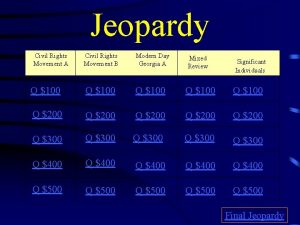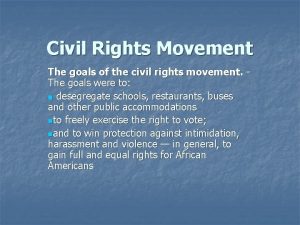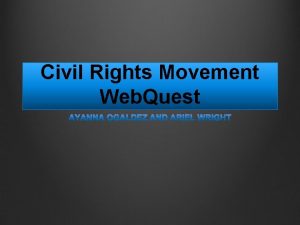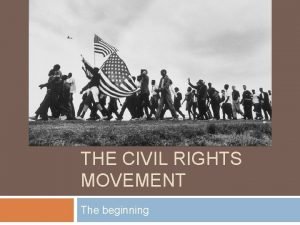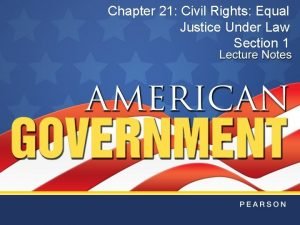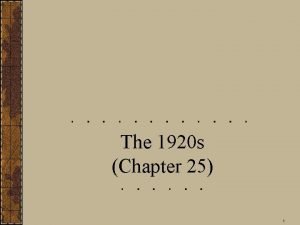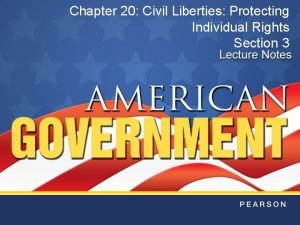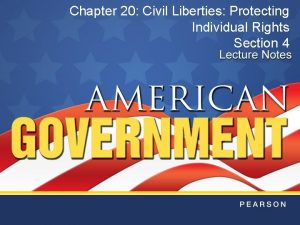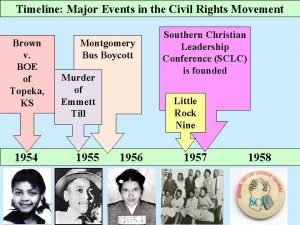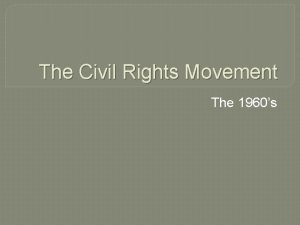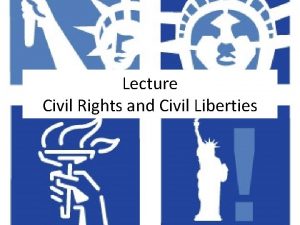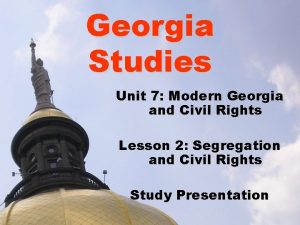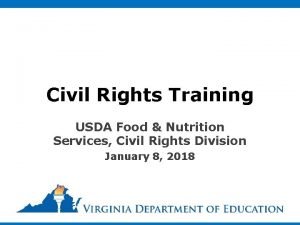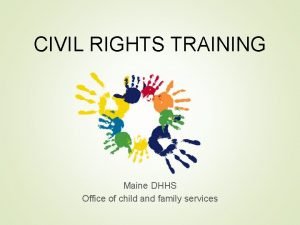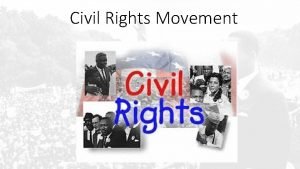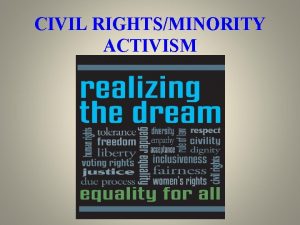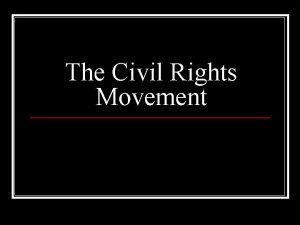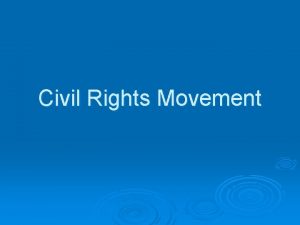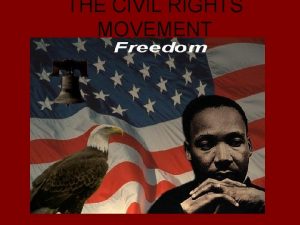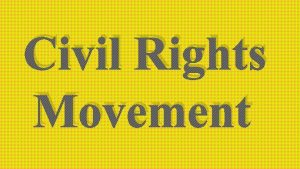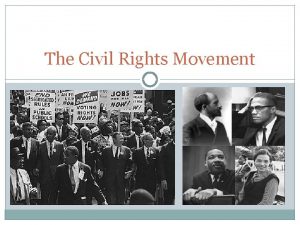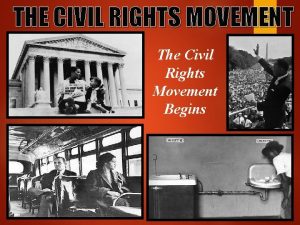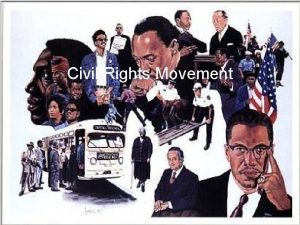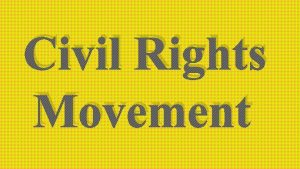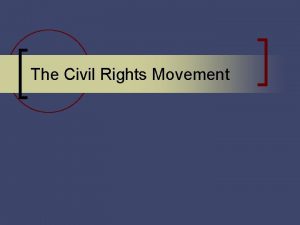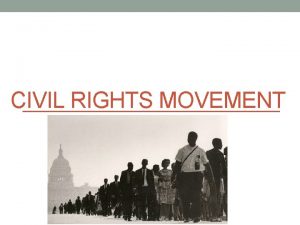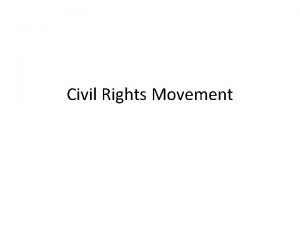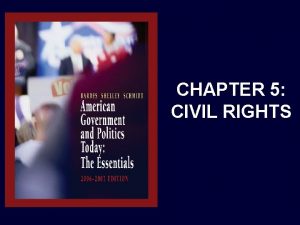CHAPTER 21 THE CIVIL RIGHTS MOVEMENT Activism new




















- Slides: 20

CHAPTER 21: THE CIVIL RIGHTS MOVEMENT Activism, new legislation, and the Supreme Court advance equal rights for African Americans. But disagreements among civil rights groups lead to a violent period for the civil rights movement.

CHAPTER 21 -1: TAKING ON SEGREGATION Activism and a series of Supreme Court decisions advance equal rights for African Americans in the 1950 s and 1960 s.

The Segregation System Plessy v. Ferguson • Civil Rights Act of 1875 act outlawed segregation • In 1883, all-white Supreme Court declares Act unconstitutional • 1896 Plessy v. Ferguson ruling: separate but equal constitutional • Many states pass Jim Crow laws separating the races • Facilities for blacks always inferior to those for whites

The Segregation System (Continued…) Segregation Continues into the 20 th Century • After Civil War, African Americans go north to escape racism • North: housing in all-black areas, whites resent job competition A Developing Civil Rights Movement • WW II creates job opportunities for African Americans • Need for fighting men makes armed forces end discriminatory policies • FDR ends government, war industries discrimination

Challenging Segregation in Court The NAACP Legal Strategy • Professor Charles Hamilton Houston leads NAACP legal campaign • Focuses on most glaring inequalities of segregated public education • Places team of law students under Thurgood Marshall • win 29 out of 32 cases argued before Supreme Court Brown v. Board of Education • Marshall’s greatest victory is Brown v. Board of Education of Topeka • In 1954 case, Court unanimously strikes down school segregation

Resistance to School Desegregation • Within 1 year, over 500 school districts desegregate • Some districts, state officials, pro-white groups actively resist • Court hands Brown II, orders desegregation at “all deliberate speed” • Eisenhower refuses to enforce compliance; considers it impossible Crisis in Little Rock • Since 1948, Arkansas integrating state university, private groups • Gov. Orval Faubus has National Guard turn away black students • Elizabeth Eckford faces abusive crowd when she tries to enter school • Eisenhower has Nat. Guard, paratroopers supervise school attendance • African-American students harassed by whites at school all year • 1957 Civil Rights Act—federal government power over schools, voting

The Montgomery Bus Boycotting Segregation • 1955 NAACP officer Rosa Parks arrested for not giving up seat on bus • Montgomery Improvement Association formed, organizes bus boycott • Elect 26 -year-old Baptist pastor Martin Luther King, Jr. leader Walking for Justice • African Americans file lawsuit, boycott buses, use carpools, walk • Get support from black community, outside groups, sympathetic whites • 1956, Supreme Court outlaws bus segregation

CHAPTER 21 -2: THE TRIUMPHS OF A CRUSADE Civil rights activists break through racial barriers. Their activism prompts landmark legislation.

Riding for Freedom CORE’s Freedom Rides • 1961, CORE tests Court decision banning interstate bus segregation • Freedom riders —blacks, whites sit, use station facilities together • Riders brutally beaten by Alabama mobs; one bus firebombed New Volunteers • Bus companies refuse to continue carrying CORE freedom riders • SNCC volunteers replace CORE riders; are violently stopped • Robert Kennedy pressures bus company to continue

Riding for Freedom (Continued…) Arrival of Federal Marshals • Alabama officials don’t give promised protection; mob attacks riders • Newspapers throughout nation denounce beatings • JFK sends 400 U. S. marshals to protect riders • Attorney general, Interstate Commerce Commission act: ◦ban segregation in all interstate travel facilities

Standing Firm Integrating Ole Miss • 1962, federal court rules James Meredith may enroll at U of MS • Governor Ross Barnett refuses to let Meredith register • JFK orders federal marshals to escort Meredith to registrar’s office • Barnett makes radio appeal; thousands of white demonstrators riot • Federal officials accompany Meredith to classes, protect his parents Heading into Birmingham • April 1963, SCLC demonstrate to desegregate Birmingham • King arrested, writes “Letter from Birmingham Jail” • TV news show police attacking child marchers—fire hoses, dogs, clubs • Continued protests, economic boycott, bad press end segregation

Marching to Washington Kennedy Takes a Stand • June, JFK sends troops to force Gov. Wallace to desegregate U of AL • NAACP’s Medgar Evers murdered; hung juries lead to killer’s release • • • The Dream of Equality August 1963, over 250, 000 people converge on Washington Speakers demand immediate passage of civil rights bill King gives “I Have a Dream” speech More Violence September, 4 Birmingham girls killed when bomb thrown into church LBJ signs Civil Rights Act of 1964 ◦prohibits discrimination because of race, religion, gender

Fighting for Voting Rights • • Freedom Summer —CORE, SNCC project to register blacks to vote in MS Volunteers beaten, killed; businesses, homes, churches burned The Selma Campaign 1965, voting rights demonstrator killed in Selma, AL King leads 600 protest marchers; TV shows police violently stop them Second march, with federal protection, swells to 25, 000 people Voting Rights Act of 1965 Congress finally passes Voting Rights Act of 1965 Stops literacy tests, allows federal officials to enroll voters Increases black voter enrollment

21 -3: CHALLENGES AND CHANGES IN THE MOVEMENT Disagreements among civil rights groups and the rise of black nationalism create a violent period in the fight for civil rights.

African Americans Seek Greater Equality Northern Segregation • De facto segregation exists by practice, custom; problem in North • De jure segregation is segregation required by law • WW II black migration to Northern cities results in “white flight” • 1960 s, most urban blacks live in slums; landlords ignore ordinances • Black unemployment twice as high as white • Many blacks angry at treatment received from white police officers Urban Violence Erupts • Mid-1960 s, numerous clashes between white authority, black civilians • many result in riots • Many whites baffled by African-American rage

New Leaders Voice Discontent African-American Solidarity • Nation of Islam, Black Muslims, advocate blacks separate from whites • believe whites source of black problems • Malcolm X —controversial Muslim leader, speaker; gets much publicity • Frightens whites, moderate blacks; resented by other Black Muslims Ballots or Bullets? • Pilgrimage to Mecca changes Malcolm X’s attitude toward whites • Splits with Black Muslims; is killed in 1965 while giving speech

New Leaders Voice Discontent (Continued) Black Power • CORE, SNCC become more militant; SCLC pursues traditional tactics • Stokely Carmichael, head of SNCC, calls for Black Power: • African Americans control own lives, communities, without whites Black Panthers • Black Panthers fight police brutality, want black selfsufficiency • Preach ideas of Mao Zedong; have violent confrontations with police • Provide social services in ghettos, win popular support

1968 - A Turning Point for Civil Rights King’s Death • King objects to Black Power movement, preaching of violence • Seems to sense own death in Memphis speech to striking workers • Is shot, dies the following day, April 4, 1968 Reactions to King’s Death • King’s death leads to worst urban rioting in U. S. history • over 100 cities affected • Robert Kennedy assassinated two months later

Legacy of the Civil Rights Movement Causes of Violence • Kerner Commission names racism as main cause of urban violence Civil Rights Gains • Civil Rights Act of 1968 prohibits discrimination in housing • More black students finish high school, college; get better jobs • Greater pride in racial identity leads to Black Studies programs • More African-American participation in movies, television • Increased voter registration results in more black elected officials

Legacy of the Civil Rights Movement (Continued) Unfinished Work • Forced busing, higher taxes, militancy, riots reduce white support • White flight reverses much progress toward school integration • Unemployment, poverty higher than for whites • Affirmative action —extra effort to hire, enroll discriminated groups • 1960 s, colleges, companies doing government business adopt policy • Late 1970 s, some criticize policy as reverse discrimination
 Civil rights and civil liberties webquest
Civil rights and civil liberties webquest Mother of the modern day civil rights movement
Mother of the modern day civil rights movement Civil rights movement jeopardy
Civil rights movement jeopardy Civil rights movement goal
Civil rights movement goal Civil rights movement vocabulary
Civil rights movement vocabulary Civil rights movement webquest
Civil rights movement webquest The civil rights movement
The civil rights movement Civil rights movement essential questions
Civil rights movement essential questions Chapter 21 civil rights equal justice under law
Chapter 21 civil rights equal justice under law Chapter 20 civil liberties protecting individual rights
Chapter 20 civil liberties protecting individual rights Chapter 14 postwar prosperity and civil rights
Chapter 14 postwar prosperity and civil rights Civil rights act of 1957 apush
Civil rights act of 1957 apush Chapter 20 civil liberties protecting individual rights
Chapter 20 civil liberties protecting individual rights Chapter 20 civil liberties protecting individual rights
Chapter 20 civil liberties protecting individual rights Period of activism and new society
Period of activism and new society Civil rights timeline of events
Civil rights timeline of events Civil rights sitins
Civil rights sitins Right to die
Right to die Unit 7: modern ga and civil rights
Unit 7: modern ga and civil rights Usda civil rights training
Usda civil rights training Civil rights training child nutrition programs
Civil rights training child nutrition programs


